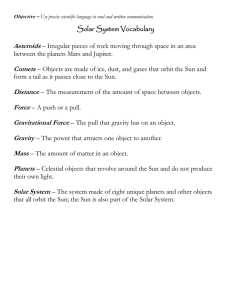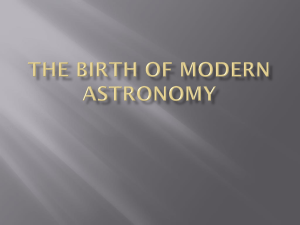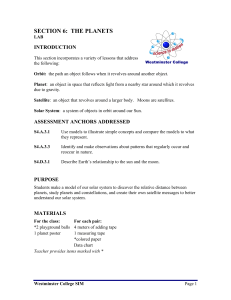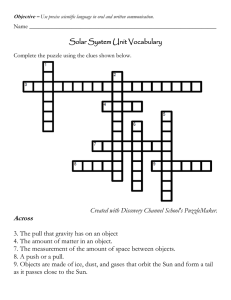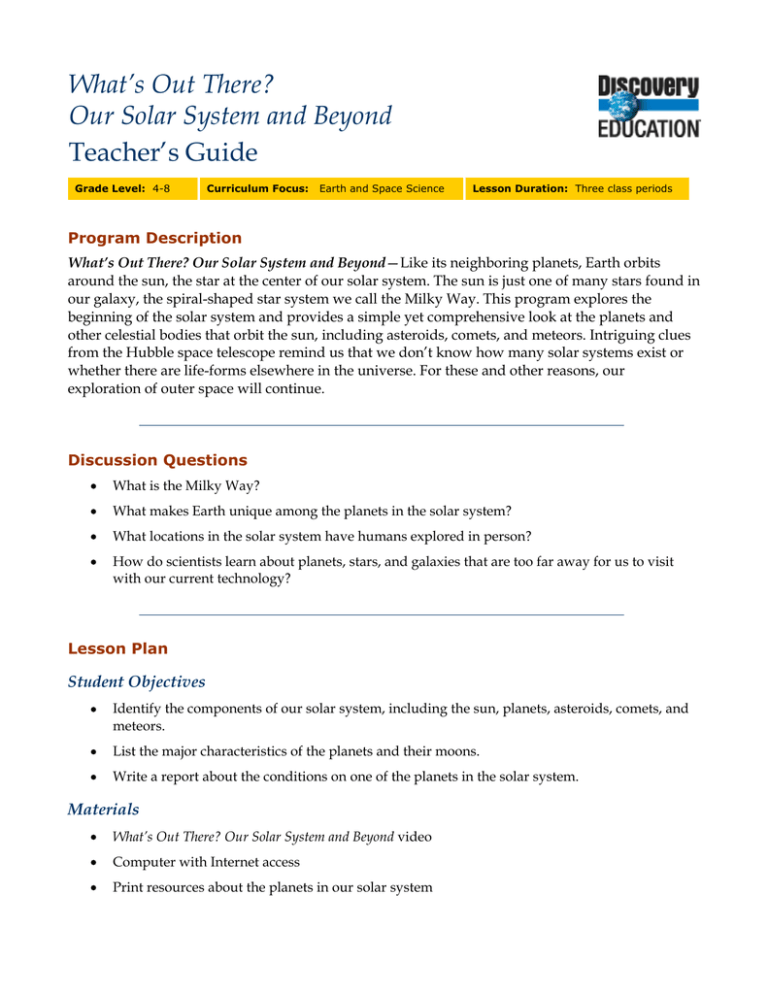
What’s Out There?
Our Solar System and Beyond
Teacher’s Guide
Grade Level: 4-8
Curriculum Focus:
Earth and Space Science
Lesson Duration: Three class periods
Program Description
What’s Out There? Our Solar System and Beyond—Like its neighboring planets, Earth orbits
around the sun, the star at the center of our solar system. The sun is just one of many stars found in
our galaxy, the spiral-shaped star system we call the Milky Way. This program explores the
beginning of the solar system and provides a simple yet comprehensive look at the planets and
other celestial bodies that orbit the sun, including asteroids, comets, and meteors. Intriguing clues
from the Hubble space telescope remind us that we don’t know how many solar systems exist or
whether there are life-forms elsewhere in the universe. For these and other reasons, our
exploration of outer space will continue.
Discussion Questions
•
What is the Milky Way?
•
What makes Earth unique among the planets in the solar system?
•
What locations in the solar system have humans explored in person?
•
How do scientists learn about planets, stars, and galaxies that are too far away for us to visit
with our current technology?
Lesson Plan
Student Objectives
•
Identify the components of our solar system, including the sun, planets, asteroids, comets, and
meteors.
•
List the major characteristics of the planets and their moons.
•
Write a report about the conditions on one of the planets in the solar system.
Materials
•
What’s Out There? Our Solar System and Beyond video
•
Computer with Internet access
•
Print resources about the planets in our solar system
What’s Out There? Our Solar System and Beyond
Teacher’s Guide
Procedures
1. Review information from the video with students.
•
How did observations by the Hubble space telescope change our estimates about the
number of galaxies in the universe? (The Hubble telescope revealed a large number of
galaxies in a small area of the universe. Based on these observations, astronomers now
believe that there may be over 40 billion galaxies in the universe.)
•
Where is the sun located? (It is one star in a galaxy called the Milky Way.)
•
What makes up our solar system? (the sun in the center, orbited by planets, asteroids,
meteors, and comets.)
•
How do scientists believe the solar system formed? (Spinning clouds of dust and gas
came together to form the sun and planets.)
•
What are the inner planets? (the four planets with orbits closest to the sun: Mercury,
Venus, Earth, Mars.)
•
What are the outer planets? (the five planets with orbits much farther away from the
sun: Jupiter, Saturn, Uranus, Neptune, Pluto.)
•
In what major ways do the inner planets differ from the outer planets? (The inner
planets tend to be small and dense with rocky surfaces. Except for Pluto, the outer
planets are very large, less dense, and do not have solid surfaces.)
•
What determines the length of a planet’s year? (the length of time it takes the planet to
orbit the sun)
•
What determines the length of a planet’s day? (the length of time it takes a planet to
make one complete revolution on its axis)
•
What is an asteroid? (a piece of rock smaller than a planet that orbits the sun)
•
What is a meteor? (a piece of rock from space that enters Earth’s atmosphere and burns
up)
•
What is a comet? (a body of ice and dust with an elliptical orbit around the sun)
•
What one quality makes Earth unique among the planets? (It supports life.)
•
What conditions on Earth make life possible? (an abundance of water and oxygen)
2. Ask students to brainstorm ways in which the environmental conditions on the surface of the
other planets in the solar system are very different from conditions on Earth. Record their
responses and read any of those below not offered by students. Possible responses include the
following:
•
They are much hotter or much colder.
•
They do not have enough oxygen in their atmosphere.
•
The length of their day-night cycle is either longer or shorter than Earth’s.
Published by Discovery Education. © 2005. All rights reserved.
2
What’s Out There? Our Solar System and Beyond
Teacher’s Guide
•
Their year (and therefore their seasons) is shorter or longer than Earth’s.
•
They get much more or much less sunlight than Earth.
•
Some have much more volcanic or storm activity than Earth.
•
None has the variety of landscapes found on Earth.
•
None has the abundance of water found on Earth.
•
Most have more moons than Earth (which could affect conditions on the planets’
surface, as the moon affects Earth’s tides)
3
3. Challenge students to learn more about conditions on the other eight planets in our solar system
and why they could not support life as we know it. Tell them they will research the planets and
choose one about which they will create a report. Have them consider these questions: How far
is the planet from the sun? How much sunlight reaches its surface? How hot or cold is it? What
gasses make up the atmosphere? How long is the day? How long is the year? Does it have a
solid surface or is the planet itself made up of liquid or gas? What landscapes exist? Does it
have volcanic or storm activity? Does it have water? How many moons does it have? Could life
exist on any of its moons?
4. Have students use print and Web resources to choose and research a planet for their report. The
following Web sites are good starting points:
•
Our Solar System
http://www.windows.ucar.edu/tour/link=/our_solar_system/solar_system.html
•
The Nine Planets: A Multimedia Tour of the Solar System
http://www.nineplanets.org/
•
Life on Mars, Life on Earth
http://www.riverdeep.net/current/2002/09/090902_mars.jhtml
•
Summary of the Solar System
http://www.solstation.com/stars/sol-sum.htm
•
Astronomy for Kids: The Planets
http://www.dustbunny.com/afk/planets/
•
World Almanac For Kids: Solar System
http://www.worldalmanacforkids.com/explore/space/solarsystem.html
•
NASA’s Astrobiology Page
http://astrobiology.arc.nasa.gov/index.cfm
•
Yahooligans: Planet Links
http://yahooligans.yahoo.com/Science_and_Nature/Astronomy_and_Space/Solar_System/Planets/
5. When students have completed their research, ask them to summarize their findings in a onepage report, explaining why life-forms from Earth could not live on the planet they chose. Also
Published by Discovery Education. © 2005. All rights reserved.
What’s Out There? Our Solar System and Beyond
Teacher’s Guide
4
ask students to design and draw a life-form with the adaptations it would need to live and
thrive on the planet, labeling and explaining at least three of the adaptations. For example, on a
cold planet, the life-form might need many layers of blubber and fur to insulate it and retain
body heat.
6. Have students summarize their reports and life-form drawings for the rest of the class,
presenting their case for why they believe the planet they chose would be an impossible place
for life-forms from Earth to live, and citing at least three adaptations an organism would need
to survive there (and to what conditions it would have to adapt).
Assessment
Use the following three-point rubric to evaluate students’ work during this lesson.
•
3 points: Students were highly engaged in class discussions; produced a complete report
and drawing, including all of the requested information; accurately summarized their report
and cited three adaptations.
•
2 points: Students participated in class discussions; produced an adequate report and
drawing, including most of the requested information; satisfactorily summarized their
report and cited two adaptations.
•
1 point: Students participated minimally in class discussions; created an incomplete report
and drawing with little or none of the requested information; did not summarize their
reports or recall any adaptations.
Vocabulary
asteroid
Definition: Space objects made of rock that never came together to form planets
Context: More than 7,000 asteroids circulate within the solar system, most between the orbits of
Jupiter and Mars.
comet
Definition: Large chunks of ice and dust that make elliptical, or oval-shaped, orbits around the
sun
Context: Energy from the sun pushes gas away from the head of a comet, creating a tail that may
be millions of kilometers long.
core
Definition: The center part of a planet
Context: Scientists believe that the core of the planet Mercury is made of iron, the same material
they believe makes up Earth’s core.
corona
Definition: The outermost atmospheric layer of the sun
Published by Discovery Education. © 2005. All rights reserved.
What’s Out There? Our Solar System and Beyond
Teacher’s Guide
5
Context: We see the sun’s corona only during a solar eclipse, when the moon blocks some of the
sun’s overall brightness.
crust
Definition: The top layer of Earth and of other solid planets
Context: Earth’s crust provides the most varied landscapes of any planet in the solar system.
galaxy
Definition: A system of many stars
Context: Our galaxy, the Milky Way, contains hundreds of billions of stars.
gravity
Definition: Force of attraction exerted by a celestial body
Context: Without the sun’s gravity holding Earth in place, the planet would careen out of its
orbit.
mantle
Definition: The layer of a planet between its surface and its core
Context: Mercury has a very thin mantle compared with the other planets.
meteor
Definition: A rock that enters Earth’s atmosphere
Context: Friction between a meteor and Earth’s atmosphere causes the meteor to burn up.
meteorite
Definition: A rock from space that reaches Earth’s surface
Context: Any part of a meteor that reaches the ground without burning up is called a meteorite.
solar prominence
Definition: A tongue-like cloud of flaming gas rising from the surface of the sun
Context: A solar prominence eruption creates spectacular displays of streamers, arches, and
loops of flame through the sun’s corona.
Academic Standards
National Academy of Sciences
The National Academy of Sciences provides guidelines for teaching science in grades K–12 to
promote scientific literacy. To view the standards, visit this Web site:
http://books.nap.edu/html/nses/html/overview.html#content.
This lesson plan addresses the following national standards:
•
Earth and Space Science: Structure of the Earth system; Earth’s history; Earth in the solar
system
Published by Discovery Education. © 2005. All rights reserved.
What’s Out There? Our Solar System and Beyond
Teacher’s Guide
6
Mid-continent Research for Education and Learning (McREL)
McREL’s Content Knowledge: A Compendium of Standards and Benchmarks for K–12 Education
addresses 14 content areas. To view the standards and benchmarks, visit:
http://www.mcrel.org/compendium/browse.asp.
This lesson plan addresses the following national standards:
•
Science—Earth and Space Sciences: Understands Earth’s composition and structure;
Understands the composition and structure of the universe and the Earth’s place in it
•
Science—Life Sciences: Understands relationships among organisms and their physical
environment
•
Science—Physical Sciences: Understands forces and motion
•
Science—Nature of Science: Understands the nature of scientific knowledge; Understands
the nature of scientific inquiry
•
Technology: Understands the nature and uses of different forms of technology
•
Language Arts—Viewing: Uses viewing skills and strategies to understand and interpret
visual media
Support Materials
Develop custom worksheets, educational puzzles, online quizzes, and more with the free teaching tools
offered on the DiscoverySchool.com Web site. Create and print support materials, or save them to a
Custom Classroom account for future use. To learn more, visit
http://school.discovery.com/teachingtools/teachingtools.html.
Credit
Renne Leatto, education and curriculum writer
Published by Discovery Education. © 2005. All rights reserved.

